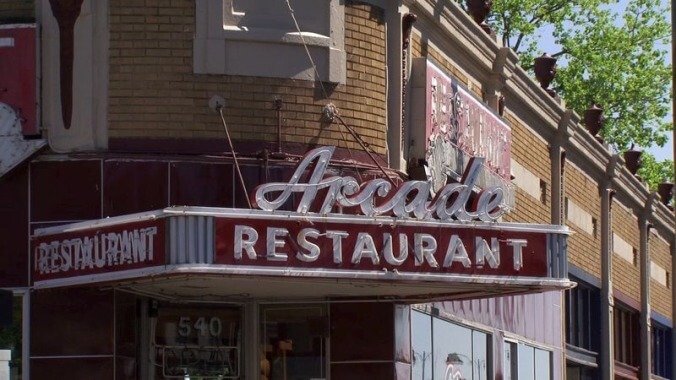But as Sherman Willmott—who worked as a production assistant on the film—tells us in this installment of Pop Pilgrims, the Arcade remained a “beacon” through it all, serving up reliably delicious food 24 hours a day in a classic diner setting. Besides, the surrounding seediness suited the needs of Jarmusch’s film. With overlapping stories that converge at the dilapidated Arcade Hotel—torn down shortly after Mystery Train shot there—it’s a film partly about how the legends of the city’s past intersect with the everyday present, and how newcomers sometimes have trouble discerning the mundane from the mythic.
In a neat twist, Jarmusch’s decision to shoot in Memphis’ less-reputable corners had an unexpected impact on the city’s onscreen life. A plaque commemorating “Modern Filmmaking In Memphis” now stands outside the restaurant, hailing Mystery Train, the first major feature to shoot primarily in the city since King Vidor’s Hallelujah! in 1928, as the beginning of a revival for filmmaking in Memphis. Jarmusch’s movie helped inspire other filmmakers to turn to Memphis, and the years that followed saw everything from Great Balls Of Fire! to The Firm to My Blueberry Nights shooting in the city. Each of those films, and others, further followed Jarmusch’s example by using the Arcade as a location. 21 Grams even has a sandwich named after it, which we found easier to stomach than the film that inspired it.
Which brings us to the big question: How’s the food? Pretty tasty, we can report. Owners Harry and Karan Zepatos, the third generation of the Zepatos family to run the restaurant, serve up classic Greek diner fare that continues to attract locals and tourists alike. Patrons can even sit in the booth once favored by another Arcade regular, Elvis Presley. Sure, it looks like every other booth at the restaurant, but that’s an element of its charm: The Arcade remains reassuringly unchanged no matter what goes on outside its doors, or who passes through them.


 Keep scrolling for more great stories from The A.V. Club.
Keep scrolling for more great stories from The A.V. Club.